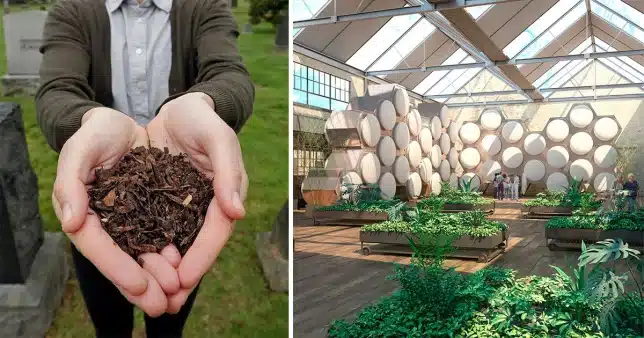Courtesy : www.uksoc.com
Composting IN U.K
Human Composting
For many years the funeral industry has only provided two options to choose from for those who have lost a loved one, burial or cremation, neither of which are earth friendly. For those wishing to choose an end of life option that allows their final act on earth to be one that gives back, a new process known as natural organic reduction or human composting is expected to become the green option of choice for many families.
What Is Human Composting?
Human composting gently transforms human remains into nutrient-rich soil that can be used to promote new life.
A unique human composting process that will allow the soil to be returned home to the family. Every person is created uniquely as therefore the human composting process can have varying timelines based on the makeup of the individual. The human composting process takes 30-60 days to complete and creates between one and one-and-one-half cubic meters of soil that can be used for returning to gardens, landscapes, or other scattering grounds as the family desires. This also allows for many family and friends to receive composted remains to create a memorial that is fit for the memories they have.
After 30 days, a body’s soft tissue has decomposed, with bones and teeth then ground up and added to the mix, which is odour-free. A special sifting machine is used to screen out artificial material such as metal screws or silicone implants. The compost is rested for a further 30 days, before being returned to family members.
The Phases of Human Composting
Human composting is a two stage process, and takes approximately 60 days to complete. These are the phases the person goes through during the human composting process.

1. Laying in.
During this stage the person is laid in a vessel on a bed of beautiful organic materials (not a coffin) such as straw, alfalfa and sawdust. Dressed in custom made compostable garments, the family are able to offer their loved one a final farewell and place with them things that are meaningful, such as flowers, sweets, letters and photos. The human composting process will then begin. During this time the natural microbes in the body will cause the temperature to rise in the vessel to between 131 and 150 degrees for anywhere from 3 to 15 days, allowing the transformation into soil to take place. Once the temperature in the vessel drops below a certain level it is time to move on to screening.

2. Screening.
Once the body has completely transformed into soil any inorganic materials are screened from the soil and recycled, this would include joint replacements, stents and screws. Next teeth and bones are broken down further to be re-introduced to the soil to complete the human composting process.

3. Resting.
At this point in the human composting process the soil needs to rest and cool for a further 30 days before being ready to return home. Any soil the family can’t take with them can be donated to nourish local flora.
Once these phases are complete, the nutrient-rich soil is returned home to your family as desired. Breathable burlap bags can be used to hold the soil, so, no chemicals need be used during the process.

Why Consider Human Composting?
Did you know that the amount of energy consumed during a cremation is about the equivalent of 30 gallons of petrol and a single cremation releases about 250kg of CO2 into the atmosphere? Any nutrients that the body contains are blown up the smoke stack as greenhouse gas. Traditional burial methods are equally harmful to the planet due to the various chemicals and wood used to embalm and make coffins. The funeral industry has separated the body from the earth with layers of concrete and rebar, and the body is not given the opportunity to break down naturally.
In fact, traditional burial methods call for the placement of some 1.5 million meters of wood, 3 million litres of embalming fluid, and 300,000 tons of concrete to be placed in the earth in a way that adds nothing of value or benefit. Human composting allows for memorialisation without perpetual land use.
Human composting is the perfect option for those who want to make their last act on earth one that gives back. Additionally, this memorial method relieves the financial burden of traditional burial for family members. There is no need to purchase a coffin and a plot of land in which you can be buried. You are encouraged to plan ahead and tell your family of your desire to be transformed into living earth. By having these important conversations you spare them the agony of guessing your end of life preferences.
The human composting process is unique in that family and friends are encouraged to be as involved as much or as little as they wish. This starts with the ritual bathing of the person and dressing them in the custom compostable garment, being present for the laying in process and placing with them mementos that are important to their memory such as letters, flowers, photos and sweets. The vessels are able to be decorated with photos and other items to create a unique memorial.
Human composting allows families to make death care decisions that help make our world a better place.



